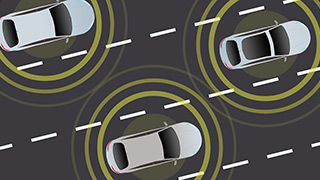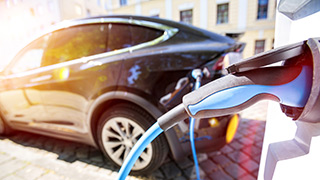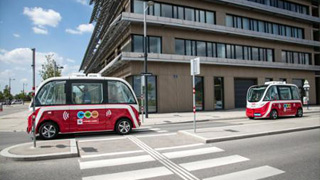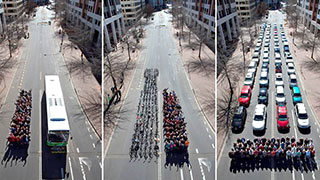Positions on Automated Mobility
The car of the future will be able to move autonomously through traffic. For the City of Vienna, this brings up the question of how automated mobility can contribute to Vienna remaining one of the world’s most liveable cities.

It is only a question of time for completely automated mobility to become mainstream.
What could urban mobility look like with automated vehicles? Will there be more or less car traffic? How is this going to affect streets and public spaces in the city? Which moral views (and algorithms) will influence mobility behaviour and traffic management? The City of Vienna answers these questions in the following statement of principles.
Vienna’s Answers to Automated Mobility
In international comparisons and rankings, Vienna stands out as one of the most liveable cities on the planet today. It is just a question of time for completely automated mobility to become widespread, but it is essential to set the right agenda for an overall mobility system that serves the common good.
Positions and Needs for Regulation
Technological development is driven by the automotive industry and the IT sector. The role of public authorities is to pay attention to the desired and undesired (side) effects.
Space and Efficiency
In analogy to urban planning, the transportation system has to follow the same basic rule: Space, being a scarce resource, has to be used as efficiently as possible. This applies especially to the rush hours. In this regard, public transportation on major routes is unbeatable. High-capacity public transport lines are irreplaceable due to their efficiency of energy and space.
Vienna’s Positions
- Focus on peripheral areas and tangential connections between major routes of public transportation
Automated services can be attractive and demand-based offers for peripheral urban areas and for the last mile (as connectors to the public underground system or private home). Automated shared taxis should complement and support public transportation in peripheral areas. For some connections with low ridership, like for instance crossways to main routes where bigger vehicles cannot be operated viably, demand-oriented mobility services can create added value. - Incentives for high levels of occupancy in vehicles
The number of people per vehicle is a key factor in terms of minimising congestion, resource consumption and emissions. That is why the City should further promote ridesharing solutions, where additional passengers use free seats. These solutions are economically and ecologically useful. - Cooperation in the region
Vienna aims for sustainable patterns of spatial development in the entire metropolitan area, which goes beyond the administrative city limits. A region of short distances is ecologically and socially advantageous. - Less need for permanent parking
Fleets of shared automated vehicles can be used more efficiently to offer transportation services and spend less time with unproductive parking. Provided that mileage remains constant, this leads to a decrease in fleet sizes and the need for parking. - Public space
We expect automated vehicles to adhere to the road rules and behave non-aggressively. It may also be assumed that their emissions will be significantly lower. This opens up new potentials for attractive public spaces with room for e.g. strolling, chatting and playing.
Safety

Automated vehicles have to be able to deal with conventional (non-automated or digitally connected) traffic participants.
Automated cars will only be permitted in Vienna if their safety of operation has been proven to be significantly higher than with human drivers.
Vienna’s Positions
- Safety first – independent of infrastructure support
Automated vehicles have to be able to manage partial system failures or inclement weather conditions, independent of infrastructure support. - Safety in mixed traffic
Automated cars have to be able to deal with "conventional" traffic, especially with pedestrians, cyclists and, of course, non-automated vehicles in mixed traffic. There will not be any new requirements for these groups. For instance, there will never be an obligation for pedestrians or cyclists to carry certain devices that allow automated vehicles to detect them more easily.
Infrastructure

Moving with electricity and without driver in the future.
A transition to automated cars will not happen overnight. The development will take place in multiple steps. This affects not just mobility planning, but also (regional) spatial planning and parking management. It is a matter of fact that public space is open to everyone in the city.
Vienna’s Positions
- Automated vehicles have to be able to deal with the existing traffic control/guidance facilities (traffic signs, road markings, etc.).
- There will not be any new, complex infrastructure in public space in order to compensate weaknesses of automated vehicles during transition periods. Any issues in this context must be solved by technological progress in vehicle technology.
- Automated vehicles must not rely on public infrastructure to enable them to drive safely. They have to guarantee their own safety of operation, also in terms of liability. Automated vehicles will adapt to public spaces, not the other way round.
- International standardisation must embrace these principles. It is not acceptable for automated vehicles to be introduced at the expense of road operators.
- Barriers through traffic infrastructure in urban spaces must not increase.
Traffic Control

Test ride with automated e-busses in Vienna’s aspern Seestadt neighbourhood.
The route a vehicle takes to its destination will increasingly be based on algorithms. Future traffic control will rely more heavily on data. Established instruments like traffic laws or street design will be complemented by a system of incentives. This extended portfolio allows for accurate traffic control, which will be easier to apply and use for all stakeholders based on automation and digital innovation.
Vienna’s Positions
- Data-based traffic management requires data
- Automated vehicles generate a lot of data on the condition of streets, traffic, routes and travel times. This (anonymised) data has to be freely accessible to public authorities for the purpose of (mobility) planning and traffic control.
- Automated mobility should contribute to democratically legitimised political goals regarding mobility, environment and the economy.
- Routing is based on the optimum for the whole system (rather than individuals)
- The choice of route is crucial. There should be no short cuts through residential areas or next to schools.
- The system should benefit from the advantages of existing high-performing public transport lines.
- Traffic congestion should be detected in advance and minimised proactively. Ideally, the connected navigation systems of automated vehicles will communicate their routing to Vienna’s traffic control headquarter via an interface. Protecting citizens’ data in line with regulations will naturally be a major concern.
- Higher quality of living and a clean environment can be possible without major sacrifices
In order to achieve this, automated vehicles have to operate without fossil fuels and show high levels of occupancy. They must be complementary to, rather than in competition with, existing high-capacity public transportation lines. If overall mileage increases considerably, however, there is a risk that the potentially positive effects could be outweighed and reversed at system level.
Citizens' Dialogue in April 2019
In April 2019 a citizen participation procedure ("citizens‘ dialogue") was held in Vienna. 100 Viennese citizens were invited to discuss the topic of automated mobility.
The same dialogue format took place in other cities in Austria and around the globe. In Austria, the events were coordinated by AustriaTech. The topics were centrally coordinated in order to ensure international comparability
City of Vienna | Urban Development
Contact form

